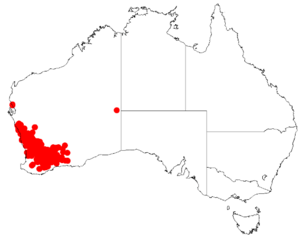Spiked wattle facts for kids
Quick facts for kids Spiked wattle |
|
|---|---|
| Scientific classification | |
| Genus: |
Acacia
|
| Species: |
multispicata
|
 |
|
| Occurrence data from AVH | |
The Spiked Wattle, also known by its scientific name Acacia multispicata, is a type of shrub. It's part of the Acacia family, which is a large group of plants. This special wattle only grows naturally in the southwestern part of Australia.
Contents
What Does Spiked Wattle Look Like?
This shrub can grow in different ways, from low and spreading to tall and upright. It usually reaches a height of about 0.2 to 2.5 meters (which is about 8 inches to 8 feet). It often looks bushy and round.
Its branches might be smooth or have a few hairs. New shoots are usually white or grey, sometimes with golden tips. Like most Acacia plants, the Spiked Wattle doesn't have regular leaves. Instead, it has special flattened stems called phyllodes that act like leaves.
These phyllodes are stiff and smooth. They can be round, flat, or slightly curved. They are usually 1 to 10 centimeters (about 0.4 to 4 inches) long and 0.8 to 1.5 millimeters (about 0.03 to 0.06 inches) wide. Each phyllode has 8 to 20 thin lines, or nerves, running along it. The tips of the phyllodes are pointed.
Flowers and Seed Pods
The Spiked Wattle blooms from March to October, showing off its bright yellow flowers. Its flowers grow in simple clusters, either alone or in pairs, right where the phyllodes meet the stem (this spot is called the axil).
The flower-heads are shaped like loose ovals or cylinders, about 8 to 15 millimeters (about 0.3 to 0.6 inches) long. They are packed with golden flowers, which is why it's called "spiked wattle" – because of these many flower spikes!
After the flowers bloom, smooth, green seed pods start to form. These pods turn brown as they get older. They are thin and look like a line, with bumps where each seed is. The pods can be up to 8 centimeters (about 3 inches) long and 3 to 4 millimeters (about 0.1 to 0.16 inches) wide.
Inside the pods, the seeds are arranged lengthwise. The seeds are black, dull or slightly shiny, and can be smooth or have small pits. They are oval-shaped, about 3 to 4 millimeters (about 0.1 to 0.16 inches) long, and have a small, fleshy cap called an aril at one end.
Spiked Wattle's Family Tree
The Spiked Wattle is part of a small group of similar Acacia plants. This group also includes two other closely related wattles: Acacia sessilispica and Acacia singula.
The scientific name Acacia multispicata tells us something about the plant. The word multi comes from Latin and means "many." The word spicata also comes from Latin and means "spiked." So, multispicata means "many spiked," which refers to the many flower spikes that cover the shrub when it's flowering. This name was given by a botanist named Benth. in 1864.
Where Does Spiked Wattle Grow?
This wattle is found in several regions of Western Australia, including the Mid West, Wheatbelt, Great Southern, and Goldfields-Esperance areas. It prefers to grow in yellow sandy soils.
You can find the Spiked Wattle from around Northampton in the north, stretching down to Cranbrook in the south. It also grows eastwards, reaching just southwest of Coolgardie and the Frank Hann National Park. It usually grows on flat, sandy areas called sand-plains, as part of heathland (areas with small, tough shrubs) or scrubland (areas with dense bushes) plant communities.

